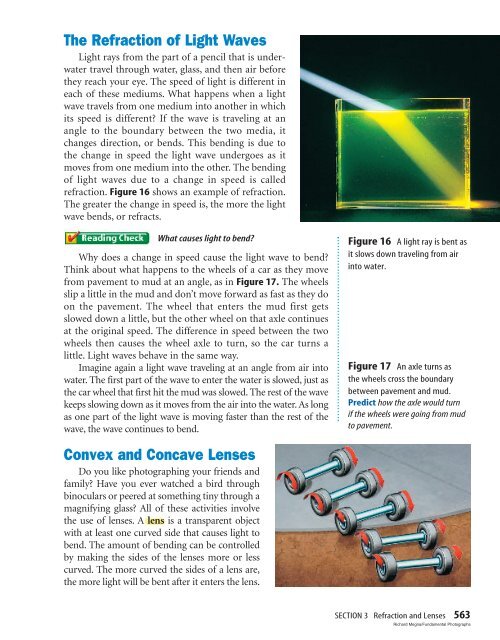Light Mirrors and Lenses (3379.0K) - McGraw-Hill Higher Education
Light Mirrors and Lenses (3379.0K) - McGraw-Hill Higher Education
Light Mirrors and Lenses (3379.0K) - McGraw-Hill Higher Education
- No tags were found...
You also want an ePaper? Increase the reach of your titles
YUMPU automatically turns print PDFs into web optimized ePapers that Google loves.
The Refraction of <strong>Light</strong> Waves<strong>Light</strong> rays from the part of a pencil that is underwatertravel through water, glass, <strong>and</strong> then air beforethey reach your eye. The speed of light is different ineach of these mediums. What happens when a lightwave travels from one medium into another in whichits speed is different? If the wave is traveling at anangle to the boundary between the two media, itchanges direction, or bends. This bending is due tothe change in speed the light wave undergoes as itmoves from one medium into the other. The bendingof light waves due to a change in speed is calledrefraction. Figure 16 shows an example of refraction.The greater the change in speed is, the more the lightwave bends, or refracts.What causes light to bend?Why does a change in speed cause the light wave to bend?Think about what happens to the wheels of a car as they movefrom pavement to mud at an angle, as in Figure 17. The wheelsslip a little in the mud <strong>and</strong> don’t move forward as fast as they doon the pavement. The wheel that enters the mud first getsslowed down a little, but the other wheel on that axle continuesat the original speed. The difference in speed between the twowheels then causes the wheel axle to turn, so the car turns alittle. <strong>Light</strong> waves behave in the same way.Imagine again a light wave traveling at an angle from air intowater. The first part of the wave to enter the water is slowed, just asthe car wheel that first hit the mud was slowed. The rest of the wavekeeps slowing down as it moves from the air into the water. As longas one part of the light wave is moving faster than the rest of thewave, the wave continues to bend.Figure 16 A light ray is bent asit slows down traveling from airinto water.Figure 17 An axle turns asthe wheels cross the boundarybetween pavement <strong>and</strong> mud.Predict how the axle would turnif the wheels were going from mudto pavement.Convex <strong>and</strong> Concave <strong>Lenses</strong>Do you like photographing your friends <strong>and</strong>family? Have you ever watched a bird throughbinoculars or peered at something tiny through amagnifying glass? All of these activities involvethe use of lenses. A lens is a transparent objectwith at least one curved side that causes light tobend. The amount of bending can be controlledby making the sides of the lenses more or lesscurved. The more curved the sides of a lens are,the more light will be bent after it enters the lens.SECTION 3 Refraction <strong>and</strong> <strong>Lenses</strong> 563Richard Megna/Fundamental Photographs

















